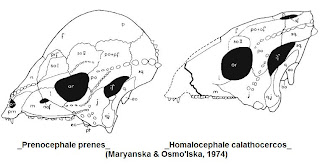
I think there’s a great circumstantial evidence to suggest synonymy. However, let’s be honest here: the only thing we know for sure now is that Dracorex is a juvenile (of something), Stygimoloch is a subadult (of something), and Pachycephalosaurus is an adult. Really, the three species could still be entirely valid, or maybe just two. It’s not a great sample size, and time will tell whether this hypothesis persists or not. I think what would be very telling is to find, in association, Dracorex and Stygimoloch, or Dracorex and Pachycephalosaurus. Given that psittacosaurs and duckbills are big on family togetherness, you’d think such instincts would be present in pachycephalosaurs, too. Maybe someday we’ll find a family association of Pachycephalosaurus that will be a better test of Horner & Goodwin’s theory.
But the idea that Dracorex = Pachycephalosaurus has an interesting implication for Mongolia’s pachycephalosaur taxa. Andrea Cau mentions this on his blog, and I think it’s worth repeating here. Note the potentially-telling similarities of Homocephale and Prenocephale. I’m especially drawn to the scute patterns behind the eyes of both animals, and the shape of the postorbital fenestrae. This is hardly a rigorous observation, but it may warrant further investigation.





2 comments:
Stygimoloch is distinct from Pachyrhinosaurus. I've never heard anyone claim otherwise. One's a pachycephalosaur, the other's a ceratopsian!
I know it's a typo. I'm just playin' with ya. :-)
Also note that the size of the skulls of Stygimoloch and Dracorex are exactly the same size. There is something unusual going on here, but I wouldn't spring for full synonymy just yet. Not to mention we need more speciments of Dracorex and Stygimoloch than one skull.
Post a Comment